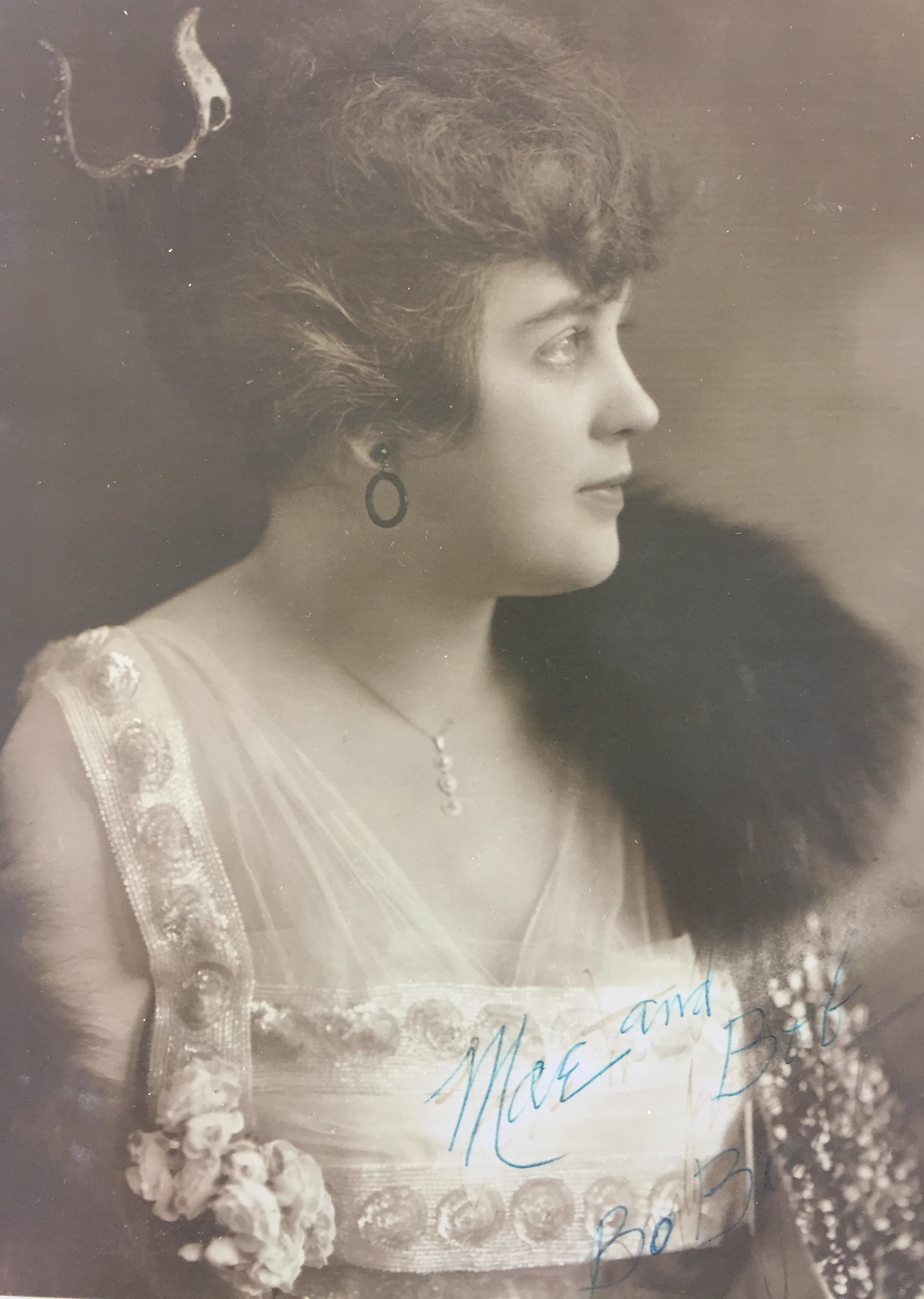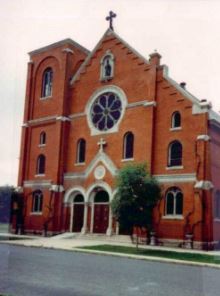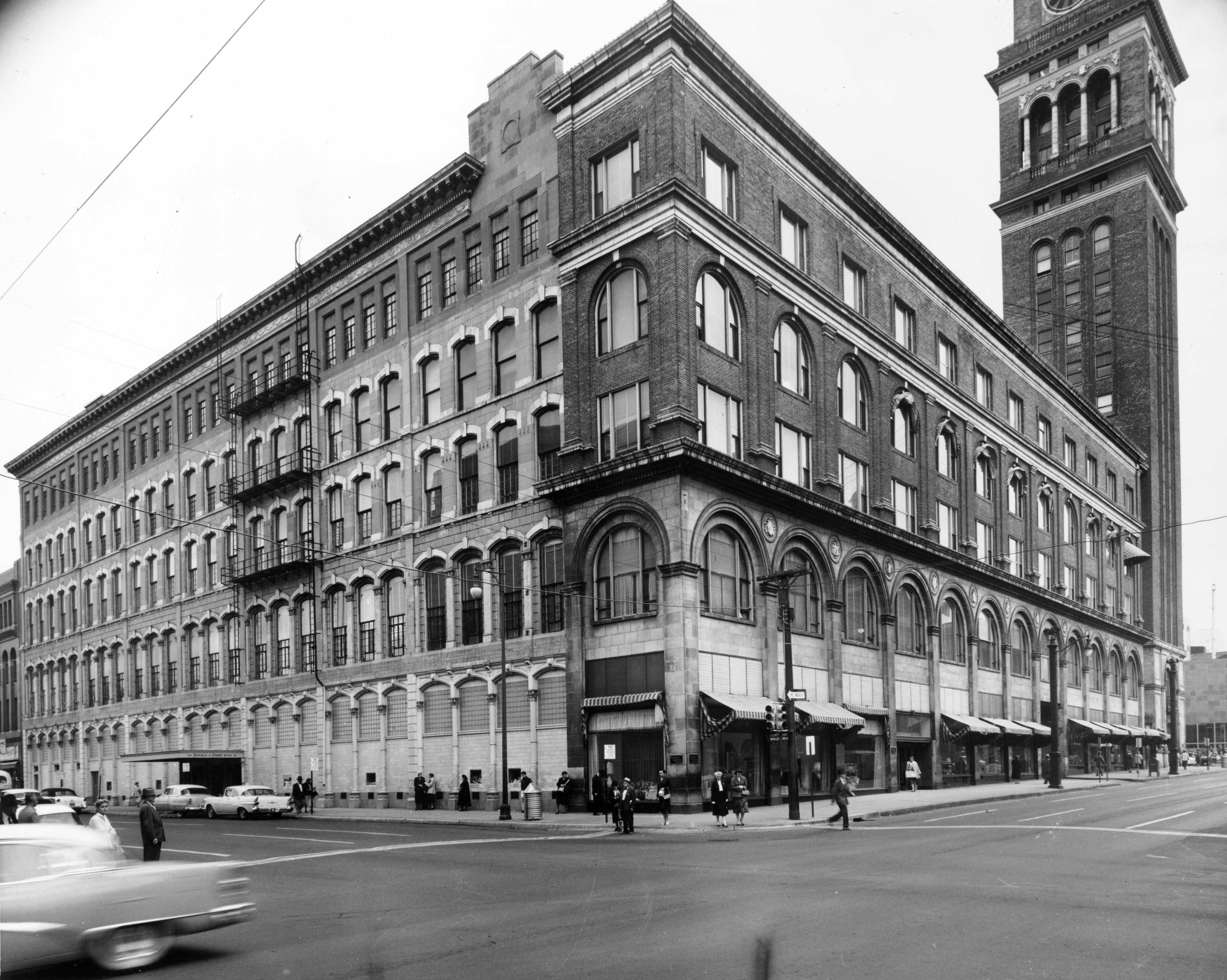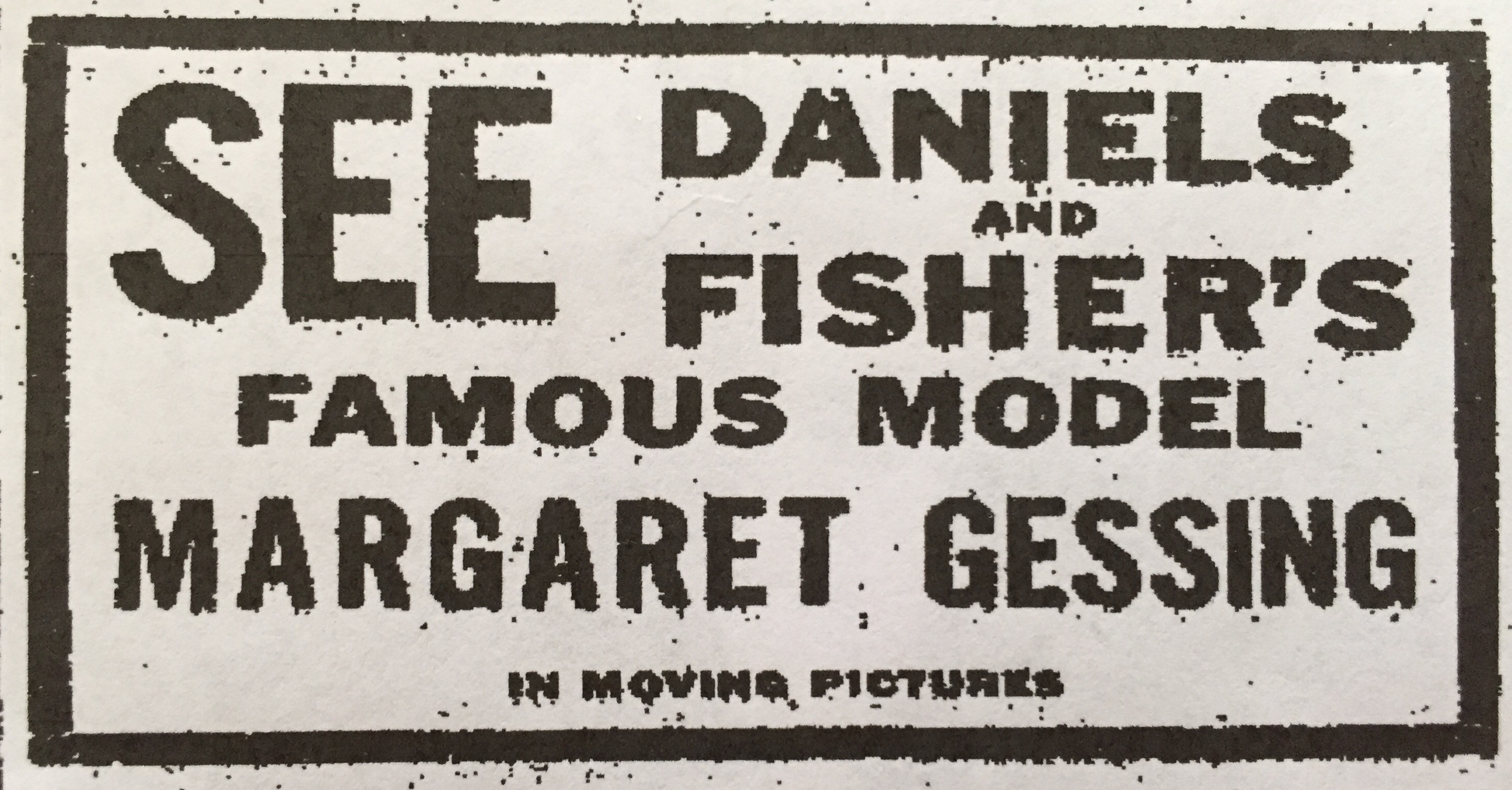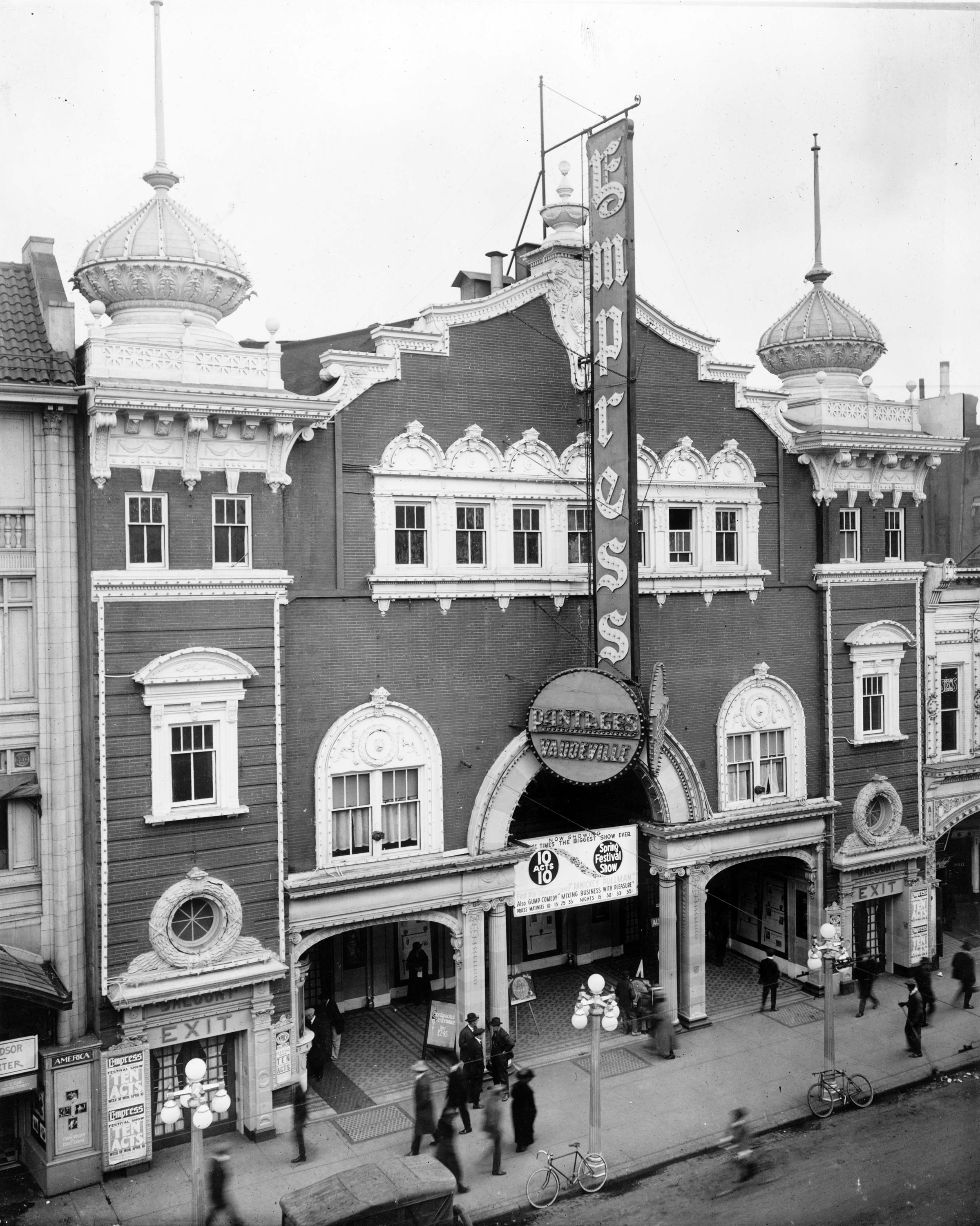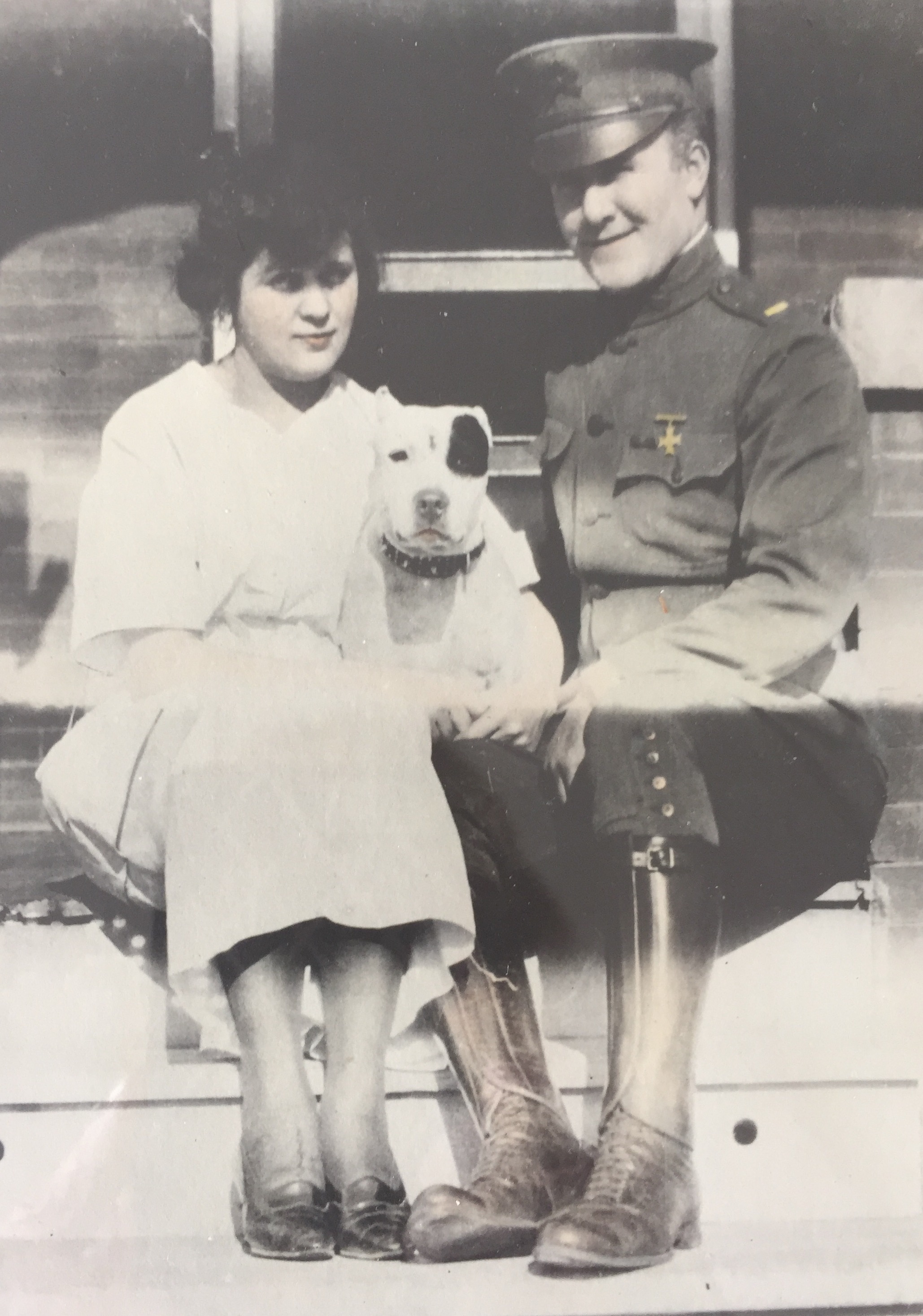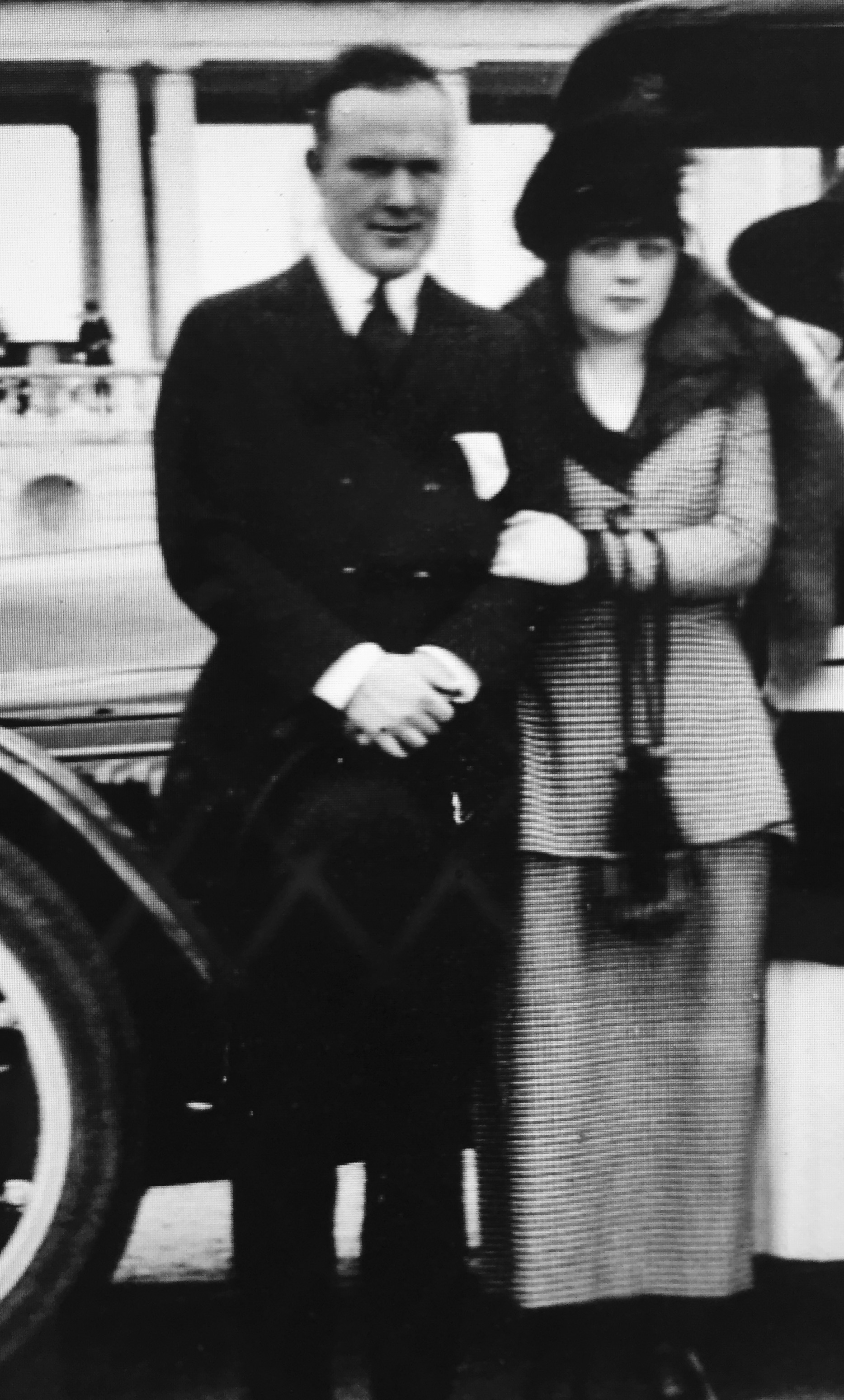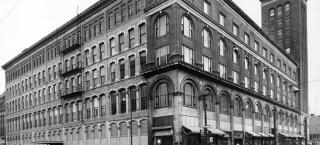
Story
Denver’s Most Beautiful Model: Margaret Gessing Bona
(10 minute read)
Over one hundred years ago, Margaret Gessing, a model for the Daniels and Fisher department store, was widely known as Denver’s most beautiful model. She not only modeled for individual customers and in fashion shows, but also was in high demand by newspaper photographers for fashion-page articles. After Margaret married a well-known and colorful mortician, Joseph E. Bona, they had a reputation for hosting great parties. Her story involves a number of notable, historic buildings of Denver's past.
Early Life
Margaret Mary Gessing was born on July 13, 1890 in the Colorado-Kansas border town of Sharon Springs, Kansas. Both of her parents were immigrants―her father, Franz “Frank” or “Francis” Gessing, from Germany and her mother, Margaret Butler Gessing, from Ireland. (Several references have the incorrect birth year and birthplace, but the best source is what the parents told the 1900 US census-taker―that Margaret Mary was nine years old at the time and was born in 1890 in Kansas.) In June of 1900, shortly after the family moved to Denver, her father died, requiring her older brothers and older sister, Alice, to support the family. In late 1902 when Margaret was twelve, the family relocated to a house at 3606 Marion Street, which is still standing. The home is in the Hyde Park Addition to Denver, a predominantly Catholic neighborhood of Queen Anne homes. At age seventeen, Margaret started working as a stock girl and clerk.
As a child, Margaret attended the neighborhood Catholic school and the church that sponsored it, Annunciation Church. At 36th and Humboldt Streets, the church is just two short blocks east from where she resided most of her adolescent life and is where her mother’s funeral mass was conducted in June 1918.
Annunciation Church
Built between 1904 and 1907, this Catholic church was placed in the National Register of Historic Places in 1990. In Margaret’s day it served an immigrant neighborhood of Germans, Irish, and Slavs. Today it still serves an immigrant population which is now predominately Mexican and Sudanese. The architecture is Gothic Revival and Romanesque Revival with stained glass windows from Germany. The interior boasts a main altar of Carrara marble carved in Italy and assembled on-site as well as statuary, oil paintings, and gilded embellishments. Annunciation Church is credited with helping to set a limit on encroachment of industrial development from the South Platte River into the neighborhood.
First Name
In the early years of the twentieth century, Margaret showed up in several newspaper articles as well as Denver city directories with the first name of "Marguerite." Whether or not this was her true name remains unknown. To friends, she was simply "Marge" while her family fondly referred to her as "Bo Bo."
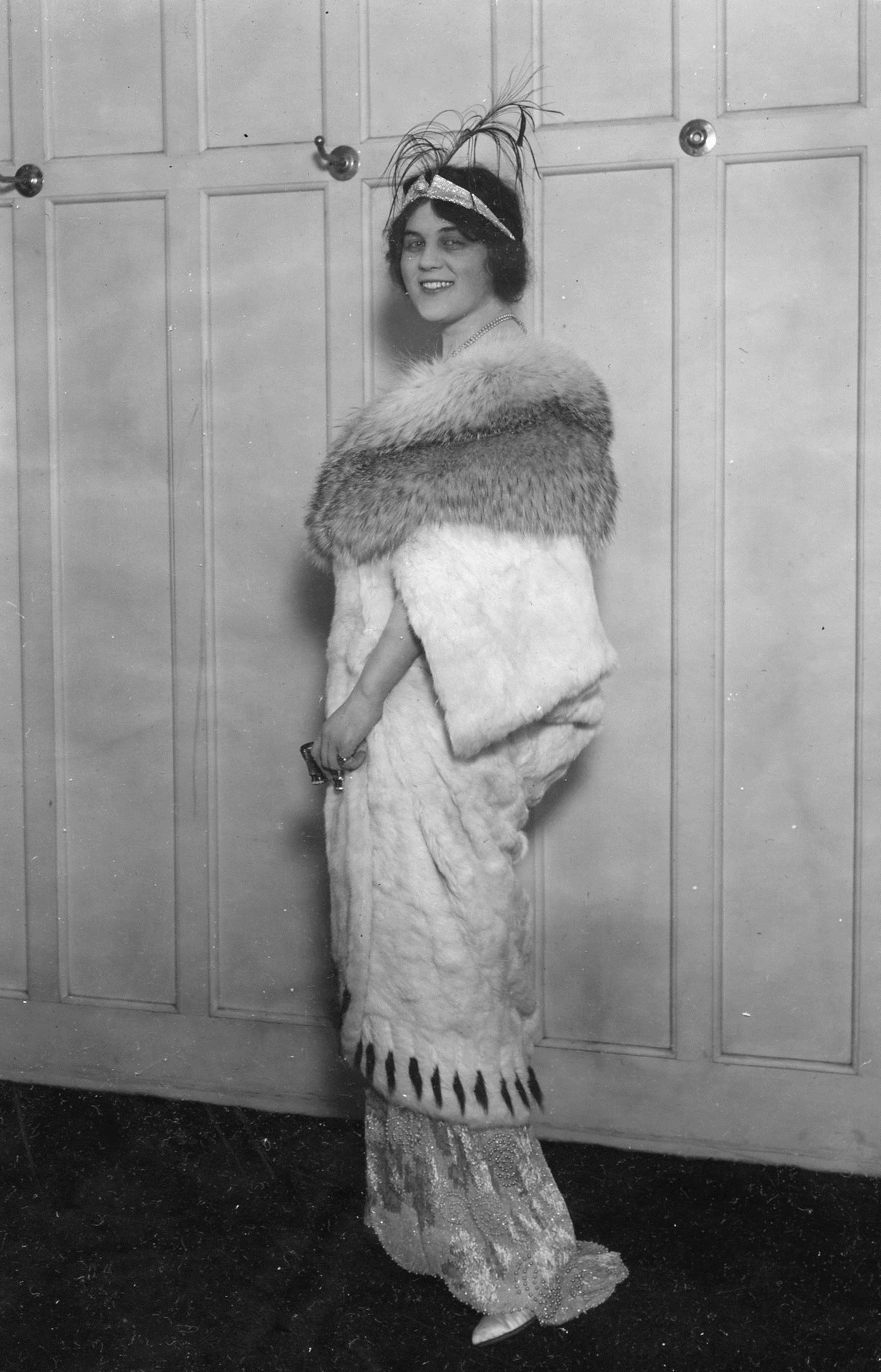
Margaret modeling an opera coat of ermine with white badger collar.
Modeling career
From 1912 to 1918, Margaret was employed as a model for Denver’s Daniels and Fisher department store. By 1917 she was also assistant-in-charge of the cloak and suit department. Margaret was featured as a model in more than twenty articles in the fashion or society pages of the Denver newspapers during that time. Most of the articles were accompanied by one to five photos of her modeling the latest fashions. She was described as “the most beautiful model in Denver,” “the prettiest, most bewitching creature outside a beauty show,” and “one of the chief attractions at the Fashion Show.” During the stock show of January 1917, autos were on display in hotel lobbies. Margaret enhanced the Willys-Knight Eight in the Brown Palace lobby as reported by the Rocky Mountain News. “Seated in the rear seat will be Miss Margaret Gessing, noted thruout the country as the ‘West’s perfect model.’ She will wear the latest styles in feminine automobile toggery from Daniels & Fisher’s.”
Modeling in the very early 1900s was a fairly new career. It was just 1858 when, in a Paris salon, the first live model (as opposed to using a static mannequin) was used. Margaret would have been summoned several times a day to model gowns for Daniels and Fisher customers. She would have modeled in a sedate manner unlike the swift pace and theatrical turns of today. Denver had an abundance of wealthy women, rich from their husbands’ gold and silver mining concerns, who were ready to view and buy expensive apparel. Margaret’s appearance in the fashion pages of newspapers was a great help in promoting the store’s seasonal new arrivals, often imported from Paris.
Fashion shows were just coming into vogue, as it wasn’t until 1903 that this country’s first fashion show was put on by the New York specialty store Ehrich Brothers. By 1910 big department stores in large US cities were holding shows of their own that were wildly popular. In Denver, “throngs of enthusiastic women” watched the D&F spring fashion show of 1912 that featured Margaret Gessing. In late September 1914, 35,000 people showed up to view the nighttime fashion show of “living models” in all the store windows up and down 16th Street. The Denver Post published a photo of the crowd in front of the D&F window where Margaret was modeling a “street suit of black velvet, with large black velvet hat with white plume.” Ironically, while the latest Paris fashions were being shown, German forces were invading French soil.
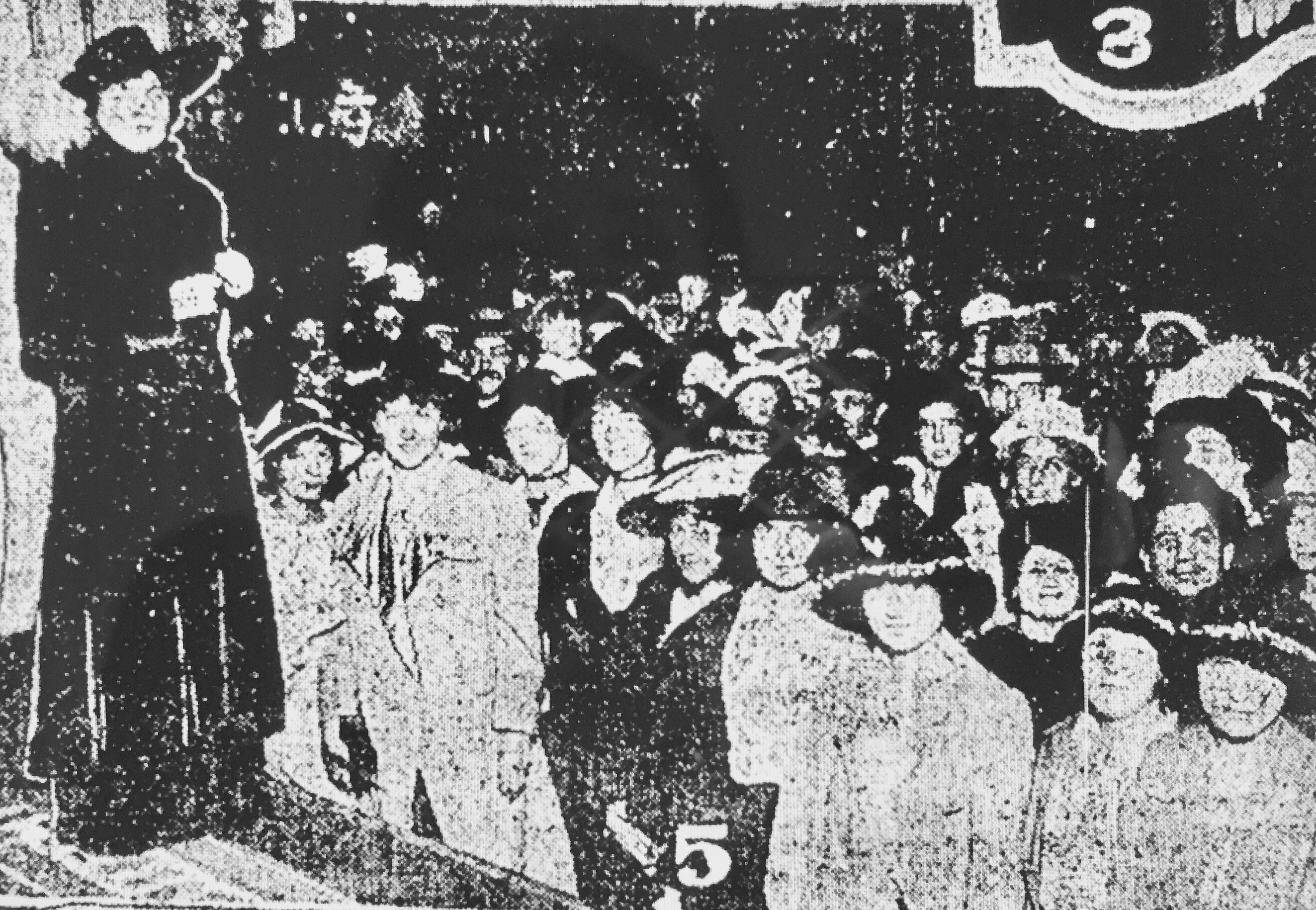
Crowd in front of the window of Daniels and Fisher where Margaret was modeling. Fashion shows were wildly popular at the time.
Daniels and Fisher & Company
In Margaret’s day, this department store was the largest in Denver at over 400,000 square feet―larger than its closest competitor, the Denver Dry Goods Company, at about 323,000 square feet. The store name “Daniels and Fisher” first appeared in 1872 when William Bradley Daniels renamed his Larimer Street store after taking in William G. Fisher as a partner. By 1876 a two-story building (which grew to five stories by 1893) was erected on newly-acquired lots at 16th and Lawrence Streets, and in 1910-11 it was greatly enlarged. The store had a reputation for high-quality merchandise. The ladies clothing department on the second floor had “imported costumes, exquisite wraps from Paris, beautiful gowns, coats and jackets from London and Berlin, [and] costly furs.” Right at the time that Margaret Gessing was starting her modeling career, the 330-foot Daniels and Fisher tower was built. The iconic tower, its base to serve as the new main entrance to the store, was added to one corner of the building during the 1910-11 expansion. Daniels and Fisher was bought by the May Company in 1958, creating May-D&F. The 16th and Lawrence building was then abandoned and, after several development ideas failed, was razed except for the tower, in 1970-71.
Moving Pictures
In 1913 Margaret appeared in a silent movie at Denver’s Empress Theater. The Empress Theater, built in 1907 and demolished in 1969, was near 16th and Curtis Streets. It was one of more than a half dozen on the Curtis Street “Theater Row” at a time when theater-going was at its peak. The Empress had vaudeville acts, movie screenings, dance marathons, etc.
One segment of a Denver Post advertisement for the Empress Theater read, “IT’S A BEAR―50 OF DENVER’S MOST BEAUTIFUL WOMEN WILL BE SHOWN IN MOVING PICTURES and after being seen at the Empress, this picture will be SENT ALL OVER THE WORLD TO BOOST DENVER.” But Margaret was the only one of those fifty who had her own stand-alone segment that said, “SEE DANIELS AND FISHER’S FAMOUS MODEL MARGARET GESSING IN MOVING PICTURES.”
Meeting Joe Bona
How Margaret met Joseph Bona is not known, but it was prior to their WWI service. Joe, mortician and son of Italian immigrants, was later part owner of Olinger Mortuary. He gained notoriety in 1917 as the mortician of the great Buffalo Bill Cody. Bringing to Denver the latest in embalming techniques, Joe was considered to be a young man on the rise and quickly gained a reputation among the general population as well as Denver’s upper crust.
World War I
In April 1917, the United States finally entered the war that had been going on in Europe since 1914. Both Margaret and Joe were involved in the war effort. Margaret dedicated her time in 1918 to “war work” at Camp Fremont, California, her exact duties not known. Built in mid-1917 specifically for WWI infantry and cavalry training, Camp Fremont closed in January 1920. Joe Bona was drafted, and on May 20, 1918 he boarded a train at Denver’s Union Station with a group of 437 draftees headed for Fort Logan, the first leg of their journey, with final destination unknown. “Prominent among the men who left with the contingent today [is] Joseph Bona, widely known business man.” The war ended on November 11, 1918, so his service was not lengthy. During his service Joe was never without a picture of his beloved, framed in his camouflage billfold.
Marriage
Joe had proposed to Margaret, and he wanted to live in Chicago, most likely because he grew up there and his parents lived there. According to current family members, Margaret told Joe that she wouldn’t marry him unless they could live in Colorado. Joe couldn’t let such a beautiful girl get away, so he ceded to her demands and they married on February 5, 1919. Five decades later, on their fiftieth anniversary in 1969, Joe Bona composed a profession of his continued love and devotion to his wife:
Now to this girl I raise my glass
To Marge my dear, my own true lass.
Heaven’s best gift, my joy, my pride
God grant me this―she not leave my side.
Social life
The couple was renowned for hosting many parties for family, society friends, and even movie stars such as Bing Crosby and Fred MacMurray. They did some of their entertaining at two mountain homes―a lodge called Bona Vista in Indian Hills and a cabin at Black Lake. Whether throwing a party or not, the Bonas were always dressed to the nines―Joe in his suit and tie and Bo Bo in her furs. They were members of several country clubs and the Denver Athletic Club.
Last residence
The 888 Logan Street apartment building (since converted to condos) was built in 1959 to appeal to the upper class. Marge and Joe Bona were the first to live in Apartment 10B and continued to live there until their deaths in 1975 and 1978, respectively. One of Bo Bo’s great nieces remembers, as a child, the anticipation of visiting their elegant tenth-floor apartment for annual Christmas Eve parties in the 1960s. Beforehand, her mother would individually groom and inspect her and her sisters and brother. Seated side-by-side on the velvet couch, the children were expected to be on their best behavior, not talking unless spoken to. Viewing the lights of the city and the beautiful white-flocked Christmas tree on the glass-enclosed balcony, they felt as though they were in a palace.
Margaret died on August 15, 1975 and is buried at Mount Olivet Cemetery in Wheat Ridge, Colorado. Both Margaret Bona and Joseph Bona lived the American dream and rose from children of immigrants to achieve success and prosperity, she as a model and he as a businessman and mortician.
Judith Stalnaker, Ph.D. is a retired Civil Engineering professor who is interested in Denver and Colorado History. She is the author of the 2015 five-part History Colorado blog series entitled 888 Logan Street: Home to the Prominent.
Rachael Harmony Heckmann received her B.A. in history from Metropolitan State University of Denver. She is the great great niece of Margaret and Joseph Bona. Rachael’s great grandmother, Alice Gessing Genty, was the older sister of Margaret Gessing Bona.
References
“Annunciation Catholic School: Our Story and Mission,” http://www.annunciationk8.org/our-story--mission.html.
“Annunciation Church,” National Register of Historic Places, https://npgallery.nps.gov/GetAsset/b0f903f7-3ec4-4eba-bca5-cfef37e8dd37/.
“Annunciation Parish and School,” https://annunciationparishdenver.wordpress.com/history/.
Barnhouse, Mark A., Daniels and Fisher, The History Press, Charleston SC, 2015.
Barnhouse, Mark A., The Denver Dry Goods, The History Press, Charleston SC, 2017.
Bona, Joseph E., poem to his wife Margaret on their 50th Wedding Anniversary, February 5, 1969.
“Camp Fremont,” Wikipedia, https://en.wikipedia.org/wiki/Camp_Fremont.
“Cheering Crowds bid Farewell to 437 Men in Draft,” Denver Post, May 20, 1918, p. 1.
Denver city directories, various publishers, 1894-1915.
Denver Clerk and Recorder, Grantee Records, Block No. 15, Hyde Park Addition, Denver CO.
Denver Post, 1912: 3/20, 9/20; 1913: 9/14; 1914: 3/22, 3/29, 5/13, 5/14, 5/15, 5/16, 9/26; 1915: 2/26, 9/25; 1916: 10/26; 1918: 3/24 (modeling) and 1913: 2/13 (movie).
“Denver’s Empress Theatre [sic],” Denver Post blog, May 30, 2013, http://blogs.denverpost.com/library/2013/05/30/denvers-empress-theater/7938/.
Evans, Caroline, “Fashion Models,” http://fashion-history.lovetoknow.com/fashion-clothing-industry/fashion-models.
Fortini, Amanda, “How the Runway Took Off: A Brief History of the Fashion Show,” http://www.slate.com/articles/arts/fashion/2006/02/how_the_runway_took_off.html.
Michigan Marriages 1868-1925, https://www.familysearch.org/ark:/61903/1:1:N3YN-XQK.
“Miss Margaret Gessing is Wed to Joseph E. Bona,” Rocky Mountain News, February 11, 1919 (marriage and Camp Fremont).
“Obituaries: Mrs. Margaret M. Bona,” Rocky Mountain News, August 17, 1975, p. 127.
“Obituaries: Margaret M. Bona,” Denver Post, August 18, 1975, p. 20.
Rocky Mountain News, 1914: 11/12; 1915: 6/19; 1916: 10/29; 1917: 1/21 (modeling).
United States Census 1900, https://www.familysearch.org/search/collection/results?count=20&query=%2Bgivenname%3Amargaret~%20%2Bsurname%3Agessing~&collection_id=1325221.
United States Census 1930, https://familysearch.org/ark:/61903/1:1:X7WT-6XS.

